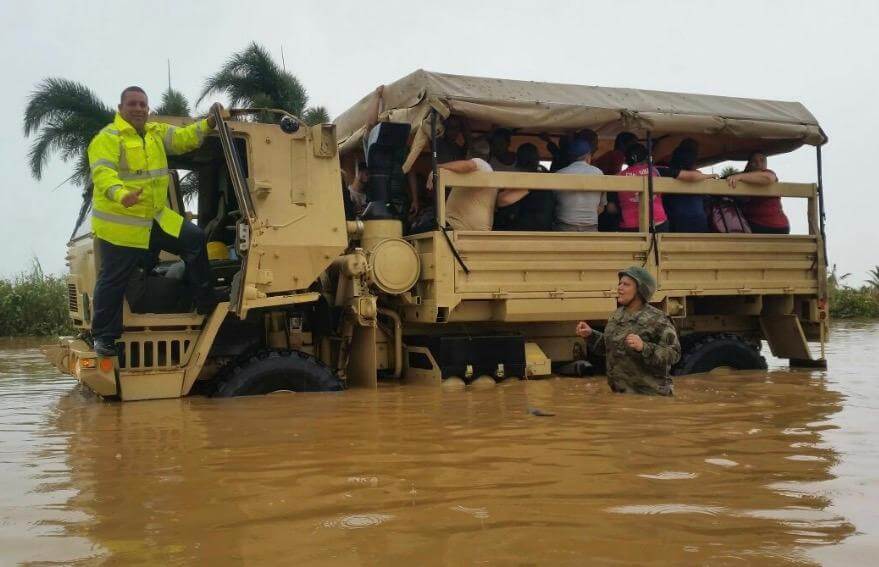Hurricane Maria stunned the world in mid-September 2017. Puerto Rico’s once pristine beaches became littered with snapped palm trees and debris. Entire neighborhoods were wiped out by 155-miles-per-hour winds and unhinged rivers of dirty, dangerous floodwaters. Families were tightly perched on roofs, awaiting rescue.
Directly on the harsh heels of Hurricane Irma, Hurricane Maria roared across the U.S. territory of Puerto Rico and into the record books, becoming the worst natural disaster to ever hit the island. According to Puerto Rican government reports, nearly 3,000 residents perished. The entire nation lost electricity for months. And the National Oceanic and Atmosphere Administration pegs losses totaled a staggering $91 billion.
Puerto Rico’s National Guard units responded swiftly, playing a key role in the immediate aftermath. But Guard members are not just first responders; they are rebuilders and future-proofers, too.
The last two years have given ample opportunity to prove that their professionalism, preparation and passion for Puerto Rico are even mightier than any Category 5 storm.
Maj. Gen. Jose Reyes was PRNG’s brigadier general, assistant adjutant general and director of joint staff when Hurricane Maria hit. Given the country’s location, a hurricane’s arrival was nothing new. The natural disaster, however, was like no other, shocking nearly everyone with its ferocity.
Reyes and his crew got to work rescuing citizens and pets. Beyond the immediate saving of lives, the PRNG eventually distributed more than 90 million bottles of water and 26 million individual meals, as well as clearing wreckage from nearly 200 miles of road.
“We were very lucky; no [Guard member] was seriously injured. Considering the magnitude of relief efforts and inherent danger involved, we were very fortunate,” Reyes said. “I attribute this to the good order and discipline of our service members.”
Among those members is Staff Sgt. Indhira Duprey-Vidal from the 783rd Support Maintenance Unit in Toa Baja. In charge of operational planning procedures and execution, Duprey-Vidal was at home hosting fellow guardsmen when Maria arrived. The next day, the trio ventured out on what would become a 26-hour rescue mission, saving more than 300 islanders including pregnant mothers, children, the bedridden and pets.
“There are no words that can describe this scenario — our fears, emotions and concerns when we arrived,” Duprey-Vidal said. “It was a really impressive scene. The type you only see in an ‘end-of-the-world’ type of movie. Everything was pitch black! Power lines were down everywhere!”
Guardsmen conducted similar spontaneous operations that night and next day, rescuing more than 3,500 residents from flooded or collapsed buildings and cars.
“The danger faced was unimaginable and without hesitation my soldiers performed heroically,” said Duprey-Vidal.
Lessons learned
According to Reyes — who has since been promoted to Dual Status Commander of all Puerto Rican military forces, those heroics have only continued since Hurricane Maria slammed the island.
“I cannot express the profound sense of pride I have for the men and women of the Puerto Rico National Guard – they are my heroes,” he said.
Yet even heroes can improve and grow, and that is exactly what the PRNG has done over the last two years. Given Caribbean hurricanes’ inevitability — especially in the era of climate change and its meteorological consequences — Reyes’ troops and airmen have instituted several significant changes to how they train for and respond to natural disasters.
At least 10% of each unit, for instance, will spend the night at the armory as a hurricane approaches; this way, instead of trying to corral guardsmen from their individual homes, at least 1,000 will be available immediately. The PRNG has divided the island into four zones, and will pre-deploy equipment and manning to each zone before a predicted major storm.
Reyes identified another needed improvement: equipment.
“Like many organizations, I believe we became too dependent on our cell phones, and paid less attention to our communications equipment,” he said. “A more aggressive preventive maintenance plan is now in place and our military radios will now be installed prior to the passing of the storm, which again cuts down our response time.”
Additionally, Puerto Rico uniquely contains 78 municipalities with 78 separate governments. The Guard has been busy visiting each one to train their first responders in emergency management exercises, building relationships with officials and paving the way for smoother disaster coordination.
Island pride
But to guardsmen like Duprey-Vidal, their homeland is worth it.
“Hurricane Maria destroyed a lot of infrastructure of our beautiful island,” she said, “but as strong-willed [as] we Puerto Ricans are, we never put our hopes down, and together we have rebuilt little by little.”
Similarly, Reyes recounts watching an elderly woman clear branches from a road with her machete. He was so touched that he stopped his Humvee to hug and thank her.
“In the days and weeks that followed the storm, although the living conditions were very tough, I saw an island that was much more unified than ever,” he said. “Everyone gave one 100% and equally helped one another. It made me feel very proud to be a Puerto Rican.”
Two years later — unlike the destructive Hurricane Maria — that pride and positivity are still present, and their redeeming forces are growing ever-stronger.

